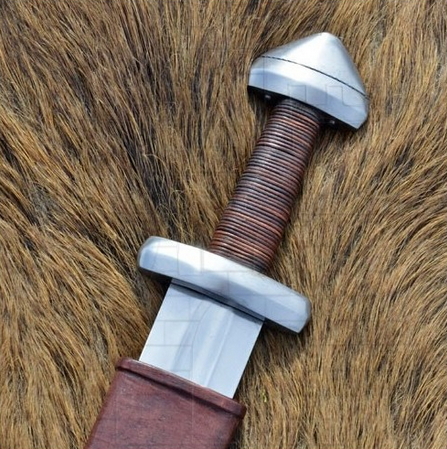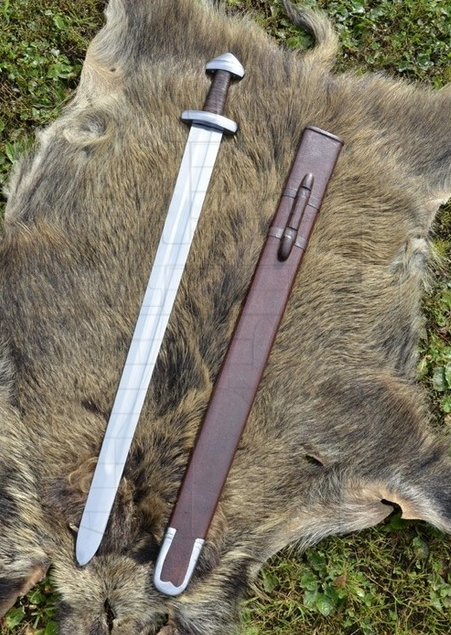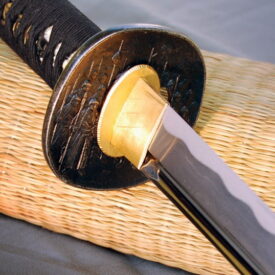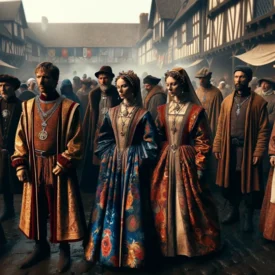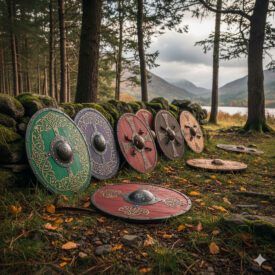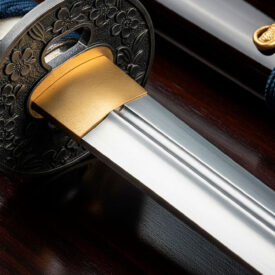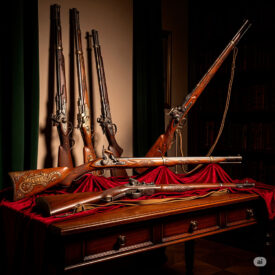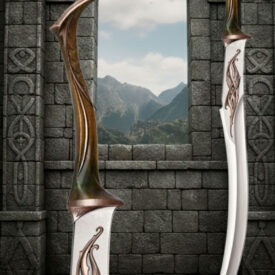The Torshov Viking sword is a historical replica that combines archaeological fidelity, functionality, and aesthetics. This article explores its origin, technical characteristics, use in historical reenactment, and practical tips for safely choosing, maintaining, and using a Torshov.
Why the Torshov Attracts Both Collectors and Practitioners
What makes the Torshov Viking sword special? It’s not only a replica based on an actual find in southern Norway, but it also offers proportions, materials, and balance designed for recreational use and display. The combination of historical authenticity and practical features makes it a highly valued piece by collectors, reenactors, and practitioners of historical European martial arts (HEMA).
Brief Historical Context: Vikings and Their Metallurgy
Between 800 and 1050 AD, the Nordic peoples solidified their presence on the European scene. Although metallurgical tradition in Scandinavia has older roots, it was during the Viking Age that swords, axes, and spearheads played a decisive role in cultural and military expansion.
The Vikings came from what is now Denmark, Sweden, and Norway. They lived in agrarian communities where agriculture and livestock coexisted with hunting, fishing, and the acquisition of metal resources. The local availability of iron and skill in forging contributed to producing effective weapons, which in turn facilitated expeditions and trade.
The Torshov find and its archaeological significance
Place names like Torshov preserve pagan vestiges — the suffix “hov” suggests the presence of a temple or place of worship — and have been key to identifying and contextualizing finds. The sword we know today as Torshov comes from a burial or rural context in southern Norway and is dated around the 14th-15th centuries in several commercial replicas; its design, however, refers to the tradition of Nordic swords that evolved throughout the Middle Ages.
Modern replicas seek to preserve characteristic proportions, pommel, and guard, while adopting contemporary heat treatments and materials that ensure durability and safety in use.
Dimensions and Proportions: What to Expect from an Authentic Torshov
Commercial replicas of the Torshov Viking sword feature very specific measurements that make it suitable for active use. Typical values recorded: total length approx. 96 cm, blade length 78.5 cm, maximum blade width 58 mm, and weight around 1,600 g. This relationship between length, weight, and center of gravity (located about 14 cm from the handle) provides agile handling without sacrificing the inertia needed for real cuts.
What each measurement implies
- Overall length (≈96 cm): allows for a posture and reach typical of hand-and-a-half swords.
- Blade length (≈78.5 cm): favors long cuts and control in thrusts.
- Weight (≈1,600 g): balanced for recreational combat work, not excessively heavy.
- Center of gravity (~14 cm from the handle): balance designed for maneuverability and control in historical techniques.
Materials and Forging: EN45 Steel and Heat Treatment
Modern functional replicas use EN45 carbon steel or spring steel that has been heat-treated. With proper hardening and tempering, a Rockwell hardness between 48 and 50 HRC is achieved. This hardness provides a balance between elasticity and resistance — sufficient to withstand tests and reenactments without becoming brittle.
The blade is usually made of carbon steel with controlled heat treatment, blunt edges and tip in many commercial versions to promote safety in practice, and a cross-section geometry designed for bending resistance.
Components of the set
- Handle: wood with a H-grip type, anatomically shaped for modern European hands.
- Pommel: triangular malleble iron crown, heat-treated for authenticity and weight.
- Guard: simple guard, in keeping with Nordic designs, provides protection and balance.
- Scabbard: wood lined with leather, fastened with fixtures for belts up to 5 cm wide.
Blade Design and Safety: Rounded Edges and Tip
Several commercial versions of the Torshov feature rounded edges and tip. This not only facilitates its use in reenactment and training — reducing the risk of serious cuts — but also complies with the regulations of many historical activities and public events. Even so, a blade with good steel and temper still offers the elastic response and characteristic sound of an authentic sword.
Handling and Use: Is it a Sword for Real Combat?
The Torshov, in its functional version, is designed for recreational practices and light HEMA. It is not recommended to subject it to extreme abuse (such as repeated cuts on hard materials without proper technique), but it is suitable for:
- Controlled training with approved protective equipment.
- Historical reenactments and staged performances.
- Supervised cutting on dummies or soft materials when the blade is professionally sharpened.
- Display and collection due to its aesthetic fidelity.
How to distinguish a good Torshov replica?
When evaluating a replica of the Torshov Viking sword, pay attention to:
- Blade material: look for EN45 steel or spring steel with specified heat treatment.
- Hardness report: indicating values between 48–50 HRC for functional use.
- Assembly: full or partially recessed tang depending on construction; avoid weak rivets.
- Finish: pommel/grip and guard union without play; well-fitted and comfortable handle.
- Scabbard: wooden interior and real leather lining with robust fastening.
Useful Comparisons: Torshov vs. Other Viking Swords
If you compare it with more economical replicas or exhibition models, you will notice clear differences in materials and heat treatment. Compared to famous swords like Ulfberht, the Torshov is usually more affordable and oriented towards practical reenactment, maintaining an aesthetic true to rural Nordic finds.
Prices and Availability
In the replica market, the Torshov is offered in a variable price range: from affordable basic replicas to better finished versions with temper certification. Prices vary substantially depending on materials, treatment, and included accessories.
Where to buy: If you are looking for a functional Torshov with guarantees, we recommend purchasing it in our online store, where we ensure clear technical specifications, shipping options, and specialized customer service.
Tips before buying
Before making a purchase, consider:
- Purpose: display, HEMA, reenactment, or collecting.
- Budget and value for money.
- Return policy and manufacturer’s warranty.
- Certifications on materials and heat treatment.
Basic Maintenance of a Torshov Viking Sword
Maintaining a Torshov in optimal condition is simple if you follow good practices:
- Clean the blade with a dry cloth after use to remove moisture.
- Apply a light coat of metal oil (3–6 months depending on ambient humidity).
- Avoid resting the blade in direct contact with damp surfaces.
- Periodically check the handle and guard union for looseness.
How to remove mild rust
For superficial rust, use fine steel wool or a specific cleaner and then reapply oil. For more serious problems, consult a professional sharpener or restorer.
Legality and Transport
Laws regarding the purchase and transport of bladed weapons vary by country. In general, unsharpened replicas with blunt tips usually have fewer restrictions, but it is always advisable to check local regulations for transport and public display. For international shipments, our online store manages packaging and documentation to ensure safe delivery.
Safety in Training and Reenactments
Using a Torshov in recreational combat requires clear rules: approved protective equipment, instructor supervision, and contact rules. Although the replica has a blunt tip and edges, HEMA projects always recommend facial protection, gloves, and a breastplate.
Customization and Options
Some manufacturers offer variations: different handle finishes, ornate pommels, blade engravings, or surface treatments that imitate antique patinas. If you want a unique piece, request customization in our online store and ensure that the heat treatment and structural integrity are guaranteed.
Common Uses in Private Collections and Museums
The Torshov is popular in display cases for its authentic appearance and the relationship between cost and historical fidelity. Collectors value its maneuverability, which allows for alternating between display and controlled testing.
Advanced Use Cases: HEMA and Experimental Reconstruction
For HEMA practitioners seeking authentic sensations, the Torshov offers a compromise between weight and elastic response. With proper technique and safety protocols, it can be used in cutting and displacement exercises, although always with limitations on cutting materials.
Historical and Emotional Value of a Well-Made Replica
Beyond technical specifications, a replica like the Torshov Viking sword connects the owner with a material and cultural tradition. It has pedagogical value for explaining metallurgy, daily life, and Viking iconography.
Checklist before finalizing the purchase
- Confirm materials and hardness (EN45, 48–50 HRC).
- View detailed photos of the assembly and finish.
- Check weight and lengths that suit your size and use.
- Find out about the return policy and warranty in our online store.
If you are looking for a reliable replica, with documented history and possibility of practical use, the Torshov Viking sword is a solid option.
Through the previous sections, you have seen its historical context, key measurements, materials, care, and purchase recommendations. Now you have the tools to decide if a Torshov fits into your collection, your training, or your historical reconstruction project.
VIEW TORSHOV VIKING SWORD | VIEW MORE VIKING SWORDS | VIEW OTHER FUNCTIONAL SWORDS
